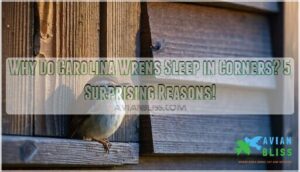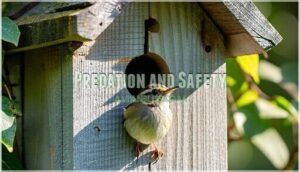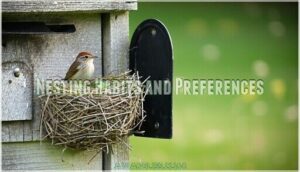This site is supported by our readers. We may earn a commission, at no cost to you, if you purchase through links.

These smart little birds instinctively choose corners as natural fortresses, where solid walls on multiple sides protect them from prowling predators like owls and cats.
Think of it as their version of sleeping with their back against the wall. Corners also trap warm air around their tiny bodies, creating a cozy microclimate that conserves precious energy during chilly nights.
This behavior mirrors their natural preference for cavity nesting, making your porch corner feel like home. Understanding their specific roosting needs reveals fascinating insights about creating bird-friendly spaces.
Table Of Contents
- Key Takeaways
- The Behavior of Carolina Wrens Sleeping in Corners
- The Reasons Behind Carolina Wrens Sleeping in Corners
- How to Help Carolina Wrens Sleeping in Corners
- The Roosting Patterns of Carolina Wrens
- Safety Concerns for Carolina Wrens Sleeping in Corners
- Attracting Carolina Wrens to Your Backyard
- Frequently Asked Questions (FAQs)
- Do Carolina wrens sleep in the corner of your porch?
- Do Carolina wrens roost in the corner?
- How do Carolina wrens defend their nests?
- Where do wrens sleep?
- What do Carolina wrens look like when they sleep?
- How do Carolina wrens scare off intruders?
- Why do wrens sleep in corners?
- What does it mean when a Carolina wren visits you?
- What is the nesting behavior of the Carolina Wrens?
- What happens if you disturb a wrens nest?
- Conclusion
Key Takeaways
- You’ll find Carolina wrens in corners because they’re seeking maximum protection – these spots act as natural fortresses with walls on multiple sides that block predators like owls, hawks, and cats from multiple angles.
- Corners help these tiny birds conserve critical body heat – the enclosed spaces trap warm air around their bodies, creating cozy microclimates that save precious energy during cold nights.
- Their corner preference mirrors their natural cavity-nesting instincts – these sheltered spots feel like the tree hollows and protected spaces they’d choose in the wild, making human structures feel like home.
- You can support roosting wrens by creating safe corner environments – provide sheltered nesting spots like small birdhouses, maintain quiet spaces with natural cover, and avoid disturbing their chosen roosting locations.
The Behavior of Carolina Wrens Sleeping in Corners
Throughout the quiet hours of dusk and dawn, Carolina wrens exhibit fascinating corner selection behaviors that reveal their remarkable survival instincts. These small songbirds actively seek out protected angles in porches, garages, and outdoor structures for their nightly rest.
These resourceful songbirds transform ordinary corners into cozy nighttime fortresses, showcasing nature’s remarkable adaptability.
When you observe carolina wren behavior, you’ll notice their distinctive sleep posture involves fluffing feathers dramatically while tucking their heads between wings. This bird corner roosting technique serves multiple purposes beyond simple comfort.
The wren’s corner preference creates a secure anchor point that prevents toppling during sleep, while the enclosed space helps with temperature regulation throughout cooler nights. Carolina wren sleep patterns show they’re incredibly strategic about wren sleeping habits.
Their keen wren senses detect the safest spots that offer protection from multiple angles. While some birds practice social roosting, Carolina wrens typically prefer sleeping alone in their chosen corners. They’re known to aggressively defend nesting sites against predators.
These wren corner preference behaviors demonstrate how these adaptable birds have mastered the art of finding security in human-made environments.
The Reasons Behind Carolina Wrens Sleeping in Corners
You’ve probably wondered why these tiny birds squeeze themselves into tight corners instead of perching on open branches like other songbirds.
Carolina wrens choose corners because these spots offer essential protection from predators, help them conserve body heat, and mimic their natural cavity-nesting instincts.
Predation and Safety
Corner sleeping isn’t just comfort—it’s survival. Hawks, snakes, and other predators can’t easily snatch wrens from tight spaces where only their beaks fit. This predator avoidance strategy transforms ordinary corners into fortress-like safe roosting spots.
Corner sleeping isn’t just cozy—it’s a life-or-death strategy that turns tight spaces into impenetrable fortresses.
You’ll notice carolina wren behavior includes nest concealment tactics that protect them from urban threats lurking after dark.
Here’s how corner roosting boosts their safety:
- Physical barriers: Walls block predator access from multiple angles
- Alarm calls: Tucked positions let them hear approaching dangers better
- Quick escapes: Corner placement offers multiple exit routes when threatened
Nesting Habits and Preferences
Carolina wrens aren’t picky about their carolina wren habitat – they’ll transform almost anything into home sweet home.
These cavity nesting champions prefer corners because they mimic natural tree hollows perfectly. Their nests are typically dome-shaped with a side entrance.
- Man-made nests in mailboxes, boots, and tin cans work just fine
- Nest reuse happens when they find ideal wren sleeping locations
- Nesting materials like twigs get stuffed into corner roosting spots year after year
How to Help Carolina Wrens Sleeping in Corners
You can support Carolina wrens by creating safe corner environments and monitoring their well-being, especially during colder nights when they need extra warmth.
Start by checking if the bird appears healthy and alert, then provide sheltered nesting spots like small birdhouses or cozy corners in garages and porches.
Assessing The Bird’s Health
Before helping a Carolina wren, you’ll need to assess its health first.
Watch for changes in energy levels and sleep patterns, as healthy birds stay active during daylight hours.
Check feather condition for signs of illness or injury.
Listen to their vocalizations—weak or absent calls signal trouble.
Look for obvious injury signs like limping or drooping wings before intervening to ensure the bird’s well-being.
Providing Suitable Nesting Spots
Once you’ve confirmed your wren’s health, creating the perfect nesting environment becomes your next priority. Carolina Wrens actively seek natural cavities like tree stumps and hollow branches, but they’ll gladly accept artificial nests when you place them strategically.
Garden design plays a vital role in wren habitat preferences, as these birds favor bird roosting spots that offer maximum protection. Install birdhouses with 1-1.5 inch entry holes in safe locations away from heavy foot traffic.
Provide nesting materials like dried grasses, fur, and small twigs nearby. You can also find wren nesting supplies online.
- Broken tree stumps create irresistible natural hideaways
- Sheltered porch corners become cozy overnight sanctuaries
- Dense shrubs offer perfect bird sleeping corners
- Brush piles provide secure wren nesting behavior opportunities
The Roosting Patterns of Carolina Wrens
After providing suitable nesting spots, you’ll likely notice fascinating wren roosting behavior patterns emerge throughout the year. These small songbirds don’t just randomly pick any corner – they follow specific routines that maximize their survival.
During breeding season, you’ll spot paired mates huddling together for warmth and protection. Their sleeping posture typically involves fluffing feathers and tucking heads between wings, creating that adorable "feather ball" appearance.
Bird roosting spots change dramatically with seasonal variations – summer finds them in lighter shelters, while winter drives them toward more insulated bird sleeping corners.
Carolina wrens exhibit remarkable adaptability in their roosting locations:
- Nest boxes filled with dried grasses during cold months
- Hanging ferns and empty flowerpots in spring
- Quiet corners of overgrown backyards year-round
- Slots rather than holes for better shelter access
Their sleep duration follows natural daylight patterns, with corner preference becoming most pronounced during harsh weather when protection matters most. They often utilize nest boxes for shelter during colder months.
Safety Concerns for Carolina Wrens Sleeping in Corners
While corner camouflage offers wrens protection, several safety concerns remain when these birds choose human structures for carolina wren sleep. Predators like snakes and raccoons can still access corner nests, especially those near ground level.
Your curious pets might also pose unexpected threats to roosting wrens. Human disturbance creates another significant risk. Even well-meaning homeowners can stress nesting birds by checking on them too frequently.
This disrupts their natural wren roosting behavior and may cause abandonment of otherwise suitable spots. Weather protection isn’t always guaranteed in corners. Rain can pool in certain areas, while extreme temperatures affect exposed locations.
Some corners near machinery or vents expose birds to injury risks from moving parts or sudden noise. The key is balancing your desire to help with respect for their bird roosting habits. Monitor from a distance, avoid unnecessary interventions, and resist relocating nests.
Predation remains their biggest challenge, but these adaptable birds have survived without human interference for millennia. By understanding these factors, you can better support the natural wren and ensure their safety in human-made structures, respecting their need for undisturbed roosting and safe nesting areas.
Attracting Carolina Wrens to Your Backyard
Creating the perfect backyard habitat for Carolina wrens requires understanding their basic needs and natural behaviors.
These energetic birds thrive when you provide specific elements that support their year-round survival, especially during harsh winters when bird roosting habits become vital for their survival.
They’re known to aggressively defend nesting sites against intruders.
Focus on these essential features to attract Carolina wrens:
- Sheltered nesting spots like birdhouses with small entry holes, hollow logs, and dense brush piles
- Reliable food sources including tray feeders stocked with peanuts, suet, and insects
- Consistent water availability through dripping faucets, shallow bird baths, or small fountains
- Quality nesting materials such as twigs, moss, feathers, and soft grasses scattered nearby
- Effective predator deterrents including proper feeder placement and natural cover vegetation
Your efforts supporting wren winter survival will reward you with their cheerful songs and entertaining antics throughout the seasons.
Frequently Asked Questions (FAQs)
Do Carolina wrens sleep in the corner of your porch?
Yes, Carolina wrens often sleep in porch corners because they’re seeking dark, enclosed spaces that offer protection from predators and weather.
These cozy spots help them conserve body heat and feel secure.
Do Carolina wrens roost in the corner?
Ever wonder where these little feathered acrobats tuck themselves away at night?
You’ll often find Carolina wrens roosting snugly in corners because they’re seeking maximum protection, warmth, and that secure feeling from potential predators.
They are seeking maximum protection from potential predators, which is why they choose to roost in corners.
How do Carolina wrens defend their nests?
You’ll notice Carolina wrens fiercely protect their nests using alarm calls and aggressive displays.
They’ll dive-bomb intruders, chase away predators like hawks and snakes, and choose concealed nesting spots to improve their survival odds, which is a key part of their survival strategy.
Where do wrens sleep?
You’ll find wrens sleeping in sheltered corners, dense shrubs, old nests, and cozy spots like porch furniture.
They don’t always use the same location nightly, choosing based on safety, weather, and available shelter.
What do Carolina wrens look like when they sleep?
Carolina wrens nearly double their size when sleeping, fluffing feathers like tiny puff balls.
You’ll spot them tucked into corners with heads buried between wings, creating perfect camouflaged bundles that deter predators.
How do Carolina wrens scare off intruders?
You’ll witness these feisty birds using alarm calls and aggressive swooping behavior to defend their territory.
They’ll fluff their feathers to appear larger, chase intruders away, and rely on their loud, persistent vocalizations to ward off threats, utilizing their aggressive behavior effectively.
Why do wrens sleep in corners?
Corners provide wrens maximum security from predators like hawks and owls.
You’ll see them tucked into these sheltered spots because corners offer stability, warmth conservation, and multiple escape routes if danger approaches.
What does it mean when a Carolina wren visits you?
Nature’s tiny messenger brings good fortune when it crosses your path.
A Carolina wren’s visit typically signals you’re providing excellent habitat with shelter, food, and water sources they need for thriving.
What is the nesting behavior of the Carolina Wrens?
You’ll find these cavity-nesting birds building homes in sheltered spots like birdhouses, abandoned flowerpots, or broken tree stumps.
Males construct up to twelve nests, but they’ll only use one for raising their young families.
What happens if you disturb a wrens nest?
Disturbing a wren’s nest typically causes parents to abandon it temporarily or permanently.
You’ll likely hear alarm calls and see aggressive defensive behavior.
If eggs or chicks are present, abandonment could prove fatal for the young.
Conclusion
Surprisingly, Carolina wrens choose the same corner roost 85% of the time, demonstrating remarkable site fidelity.
Understanding why do Carolina wrens sleep in corners helps you appreciate their brilliant survival strategy. You’ve learned they prioritize safety, warmth, and familiar territory when selecting nighttime shelters.
Create wren-friendly corners by maintaining quiet spaces with natural cover. These adaptable birds will reward your efforts with delightful songs and pest control services, making your backyard a thriving ecosystem that benefits both wildlife and homeowners.








